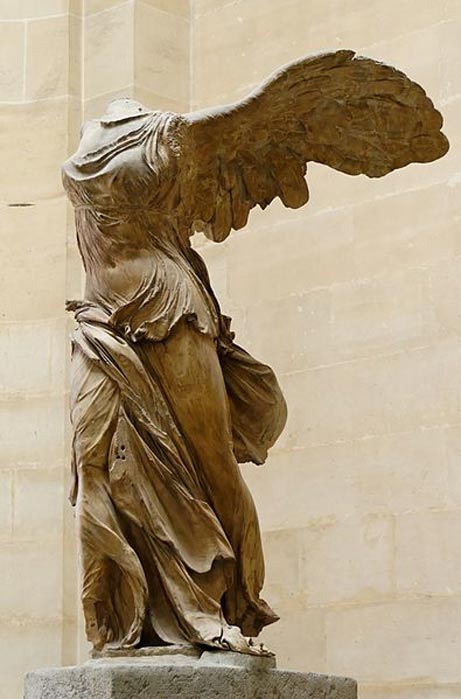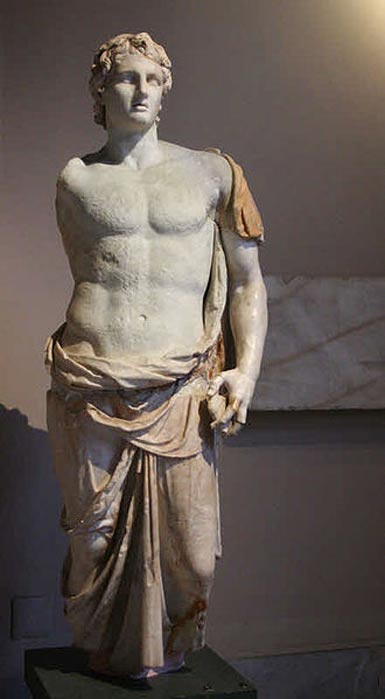
The Surprising Links Between Alexander the Great and Christianity
Alexander the Great died three centuries before Christianity officially appeared, but his cult was so strong that some symbols connected with the ancient Macedonian king were adopted by the new religion. Moreover, one of the most famous churches in Italy contains an adventurous history connected with him.
When Christianity started to gain more popularity, bishops expanded their influence very quickly. They tried to destroy ancient cults, but many people kept their faith in the old Gods. Moreover, some of them supposed that the new faith was not really new, but just a different presentation of the old beliefs.
Alexander the Great died at age 33. His death was a surprise and had a big impact on the geopolitical world of the 3rd century BC. When he died, his cult flourished. He was buried in a monumental tomb in Alexandria called ''Soma'' (Greek ''Body''). For centuries, many pilgrims visited the last palace of Alexander, worshiping him and asking for support in their daily problems or to accomplish goals. Alexander was believed to make dreams come true and to bring happiness and wealth. He wasn't just a dead king, he was regarded as a real deity, and one of the most important Gods in the Middle East, Europe, and parts of Asia.
A Pagan God in Christianity
The history of Alexander the Great highly influenced the stories which created the base for the Christian doctrine. Alexander the Great brought the Hellenistic civilization to the East more than anyone had done before him. Although many parts of Anatolia and its proximities were already influenced by the Greek language, creating the Empire of Alexander made it more popular than ever before. According to a specialist of ancient languages, it became the main reason why this language was so popular three centuries later - in the times of Jesus.

The Nike of Samothrace is considered one of the greatest masterpieces of Hellenistic art. (Public Domain)
Alexander loved peacocks. He apparently saw these beautiful birds in Asia and decided to bring them to his homeland. Their feathers became the symbol of Alexander's power, but centuries later it was adopted as the symbol of the highest bishop of the Catholic Church. Moreover, it is believed that the earliest pictures of a young Jesus portrayed the prophet of Christianity with light brown hair because it was the color of the young Alexander's hair as well.
- 3: The Perfect Number - Trinity Symbolism in World Religious Traditions
- The Canopus Way of Ancient Alexandria and the Birthday of Alexander the Great
Prophets and the King
In Judaism, it is believed that several prophets had visions of Alexander the Great many centuries before he was born. The prophet Isaiah, who lived 5 centuries before Alexander, wrote in Chapter 19, paragraph 20 about his vision:
"When (the people of Egypt) exclaim to the Lord, then the Lord will send them a man to save them. He will rule them and will save them from dangers".
Scholars suggest that the man described in this prophecy was Alexander. During Persian domination, Alexander was considered as an incarnation of the expected Messiah. The same prophet suggests that the period of his ruling would be prosperous for Egyptians and Assyrians.

Name of Alexander the Great in Egyptian hieroglyphs (written from right to left), c. 330 BC, Egypt. Louvre Museum. (CC BY-SA 3.0)
Two centuries later, Prophet Daniel foresaw that there would be a king who would occupy the throne of Solomon. The Assyrian King Nebuchadnezzar had a nightmare, so Daniel asked God about the meaning of the dream. The answer suggested that he saw the kings who would change the history of this land - including Alexander the Great. Prophet Daniel also foretold that the Hellene King would conquer the Persian Kingdom and be succeeded by four kings of his blood.

Daniel interprets Nebuchadnezzar's Dream. (Public Domain)
Also Prophet Joel in the 5th century BC saw Alexander in his visions: "Children of Juda and Jerusalem you have been attracted to the Hellenes".
It seems that Alexander was strongly expected by the nation that created the foundation for Christianity.
Hebrew and Early Christian Imprints of Alexander
In circa 70 AD, the historian Josephus Flavius wrote that after the conquering of Tyre and the siege of Gaza, Alexander visited Jerusalem. At the entrance of the city, he met the Hebrew Archpriest, Simon the Just, and many other priests and people.
Alexander always respected the rules characteristic for the places he visited, so he descended his horse and went to greet the Jewish Archpriest. Alexander’s general Parmenion suggested that the soldiers were displeased that he greeted the Jewish Priest first. Alexander answered that he didn't greet the priest, but the God he represented. As Josephus wrote:
''And when he had said this to Parmenion, and had given the high-priest his right hand, the priests ran along by him, and he came into the city. And when he went up into the temple, he offered sacrifice to God, according to the high-priest's direction, and magnificently treated both the high-priest and the priests. And when the Book of Daniel was showed him where in Daniel declared that one of the Greeks should destroy the empire of the Persians, he supposed that himself was the person intended.''
Alexander's name was added into the genealogy of the Jewish community, giving him a divine quality. Moreover, the Greek word ‘Synagogue’ dates back to the times when Alexander gave freedom for various Jewish gatherings. The annual Hebrew Convention that used to take place in Jerusalem was also called "Synitrins", from the Greek word Συνέδριο.

Statue of Alexander in Istanbul Archaeology Museum. (Public Domain)
In the times of early Christianity, St Vasilios the Great suggested that Alexander was a role model for Christian self-discipline. The main language of Christian texts was Greek. According to the Apostle Paul, Christians accepted Greek intellect and teachings, which became fundamental to the new religion.
The Venetian Tomb of Alexander
In Alexandria in the 1st century AD, St Mark, a man who was one of the paramount creators of Christianity, died. He was buried in the eastern part of the city, close to the ruined Soma. In 828 AD, during the domination of Islam, two merchants, Bruno of Malamocco and Rustico of Torcello, stole the body believed to be St Mark and took it to Venice.
- The despairing cry of the tomb of Alexander the Great from the desert at Siwa Oasis
- Tomb of Alexander the Great already found, archaeologist claims, but findings have been blocked by ‘diplomatic intervention’
Christians there built a magnificent church, currently known as the Basilica of St Mark. However, it is unknown if they actually took the remains of St Mark, an unknown person, or Alexander the Great. There are two main arguments which suggest that Bruno and Rustico could have taken the bones of Alexander to Venice. First of all, the Christian pilgrim, Bernard the Wise, described in 870 AD that the church with the remains of St Mark was located out of the eastern walls of the city.

St Mark's Basilica. (Public Domain)
The most suggestive part of the story is a strange sign carved on the tombstone of a man who is buried in the Basilica nowadays. It is a symbol which looks like a symbol of a star characteristic of the dynasty of Alexander the Great. Unfortunately, no researchers have had the opportunity to examine the remains covered under this tombstone. It would be very easy to find out if the remains belong to Alexander as opposed to St Mark - the Macedonian king was mummified and fully decorated with gold.
A King of Nations
Alexander the Great appears in Christianity, Islam, Buddhism, Judaism, and Hinduism. He lived a relatively short life, but his charisma was stronger than death. In early medieval times, Christian women in southern Europe believed that a coin depicting Alexander would bring them happiness on their wedding day and in their marriage. With the expansion of devotion to Jesus, Alexander lost some popularity, but his name has never been forgotten.

The detail of the Alexander Mosaic showing Alexander the Great. (Public Domain)
Featured image: Summit Cross (Public Domain), and a statue of Alexander the Great in Khujand, Tajikistan. (CC BY-NC 2.0)
References:
Nicholas J. Saunders, Alexander's Tomb. The Two Thousand Year Obsession to Find the Lost Conqueror, 2006.
Vojtech Zamarovsky, Tropami Siedmiu Cudów Świata, 1990.
http://www.macedonia.info/Martis_connection.htm















Comments
I would like to let you know that i am one of
alexanders descendant i am st marc
A puzzle (no reward in cash!):
(i) He was from a royal ancestry.
(ii) It was claimed he was a son of God.
(iii) He lived 33 years.
(iv) His body after his death has never been found.
Now: What was his name?
Is amazing to learn historic facts, but this story of the wrong tomb was invented by masons envious or by Muslims seeking to weaken the entrance to the Occidental World in Veneto. 'Allora', all the stars are symbols of the Alexander the Great? 'Abbia pietà'...
Werever are the remains of St. Mark, the big History, his legacy and great work for the Christianity is undeniable!
Par tera, par mar, San Marco!
W SAN MARCO!!!
More amazing is, how people could accept such a nonsense (acceptance of a war as something amazing) as amazing and seek something mysterious where it doesn't exist. We humans are extremely good in deluding ourselves and falling in love with illusions. Guess that's natural: after all, we are equipped with five senses which actually are nothing but an illusion tool: our eyes conceive a reality (with so called "light" and colors) which actually "doesn't" exist (as in, everything we sense is the reality our brains conjure), we taste, smell things because certain signals make us feel in certain ways etc etc. One just can't help but think, "why are our lives full of lies?!" and then you realize there must be some other higher purpose for all of this charade.
its amazing how an event or war can have lasting effects just a few hundred years later.
Troy Mobley
Pages